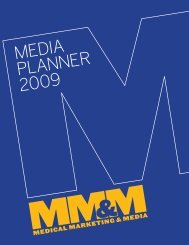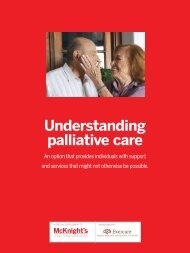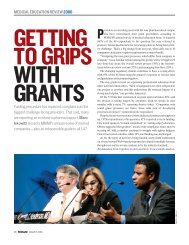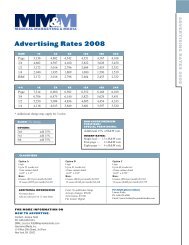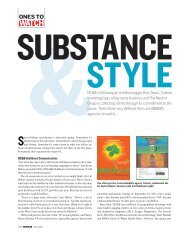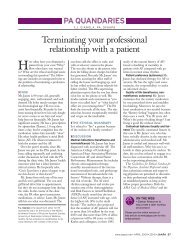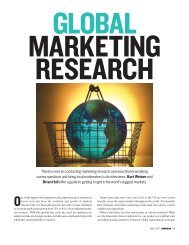Essential Guide to E-mail Marketing - Haymarket
Essential Guide to E-mail Marketing - Haymarket
Essential Guide to E-mail Marketing - Haymarket
Create successful ePaper yourself
Turn your PDF publications into a flip-book with our unique Google optimized e-Paper software.
06 FEATURE DM News • E-Mail <strong>Marketing</strong> <strong>Guide</strong> 2007<br />
Case Study:<br />
Taxbrain<br />
Following the law does not outlaw acquisition<br />
potential.<br />
Online financial services firm TaxBrain<br />
reports <strong>to</strong> having increased its new cus<strong>to</strong>mer<br />
acquisitions by 500 percent, and at the same<br />
time keeping good with the laws required of<br />
financial services companies privacy regulations<br />
and CAN-SPAM, by using e-<strong>mail</strong>.<br />
TaxBrain had been faced with a quandary:<br />
How <strong>to</strong> acquire cus<strong>to</strong>mers through often affiliate<br />
marketing but not violate CAN-SPAM while<br />
doing so.<br />
“As a company that is trying really hard <strong>to</strong><br />
build a brand and gain consumer trust, it is critical<br />
that we maintain a spotless reputation,” says<br />
Craig Petz, vice president of marketing and<br />
sales at Petz Enterprises Inc., crea<strong>to</strong>r of<br />
TaxBrain.com. “On the other hand, in order <strong>to</strong><br />
build my brand and increase my clientele, I have<br />
<strong>to</strong> look for ways <strong>to</strong> acquire new cus<strong>to</strong>mers.”<br />
TaxBrain was initially hesitant <strong>to</strong> participate<br />
in affiliate marketing via e-<strong>mail</strong> despite the<br />
potential that e-<strong>mail</strong> has as an acquisition <strong>to</strong>ol.<br />
“With passage of the Graham-Leach-Bliley<br />
Act, the definition of a financial institution<br />
CS: We’re going <strong>to</strong> have the authentication and the login process,<br />
that’s a big part of it. We’re also going <strong>to</strong>, like I said, limit the number<br />
of ports that can be used. But when those messages are coming<br />
in from the Internet, then we have <strong>to</strong> look at other characteristics<br />
of the message. Primarily, what we are looking at right now is<br />
the source of the message, which allows us <strong>to</strong> determine whether<br />
this is somebody we would normally be doing business with. Is<br />
this somebody that would normally be sending a million messages<br />
like this? If not, then we try <strong>to</strong> put them on a slow track and identify<br />
what’s coming in. Is this a legitimate message or not, and if<br />
not, then we just simply issue a block. And we advise the sender<br />
that we have blocked their message. And if they feel that it’s an<br />
error, they need <strong>to</strong> contact us.<br />
DM News: A few years ago, the industry recommended not using<br />
images in e-<strong>mail</strong>, being mindful of the subject line, things like that.<br />
Is this obsolete now that we have more sophisticated technologies<br />
that allow you <strong>to</strong> look at the authentication process and better<br />
understand where <strong>mail</strong> is coming from? Do these things still matter?<br />
Are subject lines still filtered?<br />
CS: Actually, we don’t do a whole lot of filtering on the subject line.<br />
The most effective filtering goes on right at the consumer inbox, and<br />
typically that does come from the subject line and the “from”<br />
address. Consumers play a huge role in determining what is and<br />
what is not spam on the AOL system. But also for their own inbox,<br />
anything that is delivered, certainly they have that opportunity <strong>to</strong> say,<br />
was greatly broadened <strong>to</strong> include not only<br />
banks, broker-dealers, and insurance companies,<br />
but also the real estate industry, financial<br />
advisors, tax businesses and more,” Petz<br />
says. “Many marketers in this sec<strong>to</strong>r have<br />
simply dropped, or greatly limited, their use<br />
of e-<strong>mail</strong> marketing.”<br />
However, the firm was still looking <strong>to</strong><br />
increase its business and compete with other<br />
online tax services firms such as H&R Block<br />
and Turbo Tax. These concerns drove<br />
TaxBrain <strong>to</strong> seek a third party compliance<br />
platform <strong>to</strong> help guide through the complexities<br />
of compliance, and still participate in<br />
affiliate marketing. Due <strong>to</strong> restrictions from<br />
the IRS, TaxBrain could not share suppression<br />
lists in plain-text.<br />
TaxBrain began using Datran Media’s<br />
UnsubCentral platform, which manages this<br />
IRS requirement by using a suppression list<br />
distribution software that eliminates plaintext<br />
sharing and is fully scaleable <strong>to</strong> meet the<br />
tax firm’s largely seasonal business, especially<br />
each mid-April. Before a <strong>mail</strong>ing is sent out<br />
with new names from affiliates, UnsubCentral<br />
scrubs the lists for any unsubscribes.<br />
“The good news is that there are now technologies<br />
in place that enable highly effective<br />
ESSENTIAL GUIDE<br />
e-<strong>mail</strong> campaigns without compromising<br />
security,” Petz adds.<br />
To do it right, TaxBrain refrained from affiliate<br />
marketing until it integrated compliance<br />
across its online business and partnerships.<br />
Since the integration, the firm has seen<br />
record growth in revenue.<br />
“As online, do-it-yourself income tax<br />
preparation has become the preferred<br />
method of paying taxes for more than half of<br />
the 132,000,000 US taxpayers, acquisition<br />
marketing is critical and has become a core<br />
component of TaxBrain’s revenue model,”<br />
Petz comments. ■ —by Dianna Dilworth<br />
“You know what, I think that this is spam, I am not going <strong>to</strong> trust it.”<br />
Or they are going <strong>to</strong> trust it, and that’s why we always err on the<br />
side of caution <strong>to</strong> make sure that the message does get delivered.<br />
DM News: If a consumer receives a message that he doesn’t want,<br />
but it is something that he’s opted in for, is it bordering on spam?<br />
How can marketers and consumers bridge this gap?<br />
CS: I think that that’s a very dangerous area for us <strong>to</strong> play in, in<br />
determining what is or is not spam. Whether that example is criminally<br />
spam, I would say no, it is not. However, what our consumers<br />
tell us is spam — whether they have opt-ed in for it or not<br />
— that’s what we’ve got <strong>to</strong> filter. Because our consumers are essentially<br />
asking us, “Please don’t deliver this message <strong>to</strong> me.” Even if a<br />
marketer did have express written consent from the consumer saying<br />
he wanted the message, if they had copies of his driver’s<br />
license, knew his address, his telephone number, blood type, if at<br />
the end of the day, the consumer says, “I don’t want it,” then we<br />
want the <strong>mail</strong>er <strong>to</strong> s<strong>to</strong>p <strong>mail</strong>ing it <strong>to</strong> them.<br />
DM News: So what should a marketer do? How does a company<br />
find out that a consumer doesn’t want a message if he’s already<br />
opted in?<br />
CS: One of the ways we do that is with our “report spam” but<strong>to</strong>n.<br />
And we provide those reports back <strong>to</strong> the <strong>mail</strong>er <strong>to</strong> let them<br />
know that, for whatever reason, this consumer doesn’t want it.





